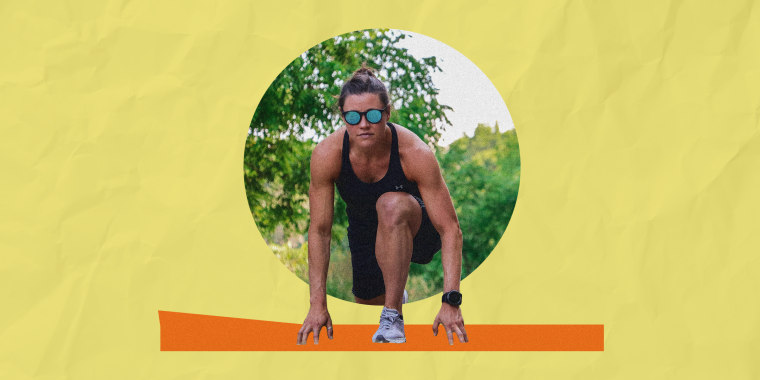Long distance runner Emily Rudow, 31, was afraid that if she changed her exercise and diet routine, she’d lose the fitness gains she made over the years. The only thing holding her back from getting in better condition, she said, was fear.
“I was just scared,” Rudow, a freelance digital marketer who lives in Toronto, told TODAY. “It was like this fear that was holding me back from making a big change.”
But after a long-term relationship ended last January, she realized she needed to also break up with her routine.
“I just wanted to become an individual again and make a change,” said Rudow, who also co-owns a sports apparel company.
Rudow began researching how to switch up her workouts through online videos, journals and articles, she said. Educating herself about fitness, she said, helped ease her anxiety about change. “That opened the doors for being more open-minded to new information and testing out new workout routines and a new diet,” she said.
Rudow said switching up her exercise and diet regularly, which she originally wrote about on Medium.com, has made a “big difference in my physique,” because doing so forces her muscles to grow. Not only has she gained a trimmer waistline, she also estimates she’s put on about five pounds of muscle. Here’s how she did it.

She constantly switches up her routine
Rudow’s old workout routine primarily focused on running with upper body strength training three days a week. She consistently stuck with the same exercises and never increased the weight, even as the weights became easier (what’s often referred to in weight training circles as “progressive overload”).
The first big change she made was dividing “pull” and “push” upper body workouts into separate workout sessions, which she said helped her isolate muscle groups. A “pull” workout is any workout where your muscles contract when weight is pulled towards your body, she explained, whereas a “push” workout is any workout where your muscles contract when the weight is pushed away. Here is what her new routine looks like:
Monday: Pull upper body workout
Tuesday: Pull leg workout and core
Wednesday: Push upper workout
Thursday: Push leg workout and core
“I think that's really what moved the needle,” she said.
Every session, she picks five different exercises for each muscle group and completes 3-4 sets of each workout with 8–15 reps. She varies her workouts even further by mixing in some lower (4-6) and higher reps (+15), as well. She also pushes her muscle to fatigue, she said. Once a weight becomes easy, she moves on to the next heaviest weight.
To prevent her body from plateauing, she tries to adjust her routine about every three weeks — adding a new workout for each muscle group. She also changes the order of the exercises, she says.
She also runs every day, varying her routine between longer and shorter distances, at different intensities, depending on the day.
She varies her diet
Rudow also made a big change to her diet. Before, she stuck to high-nutrition foods about 80 percent of the time, she estimates, and did not track her calories. After downloading the app MyFitnessPal, she began tracking everything she ate, and realized she was eating way more than she thought.
Using the data, she tracks her calories and “macro” nutrition (fat, carbs and protein), and created a new dieting technique that works for her. Through experimentation, she figured out how much she needed to eat to lose fat while also gaining strength. Since she runs often, she realized that she operates best on a high carb, low fat diet.
She also varies her diet, eating at a calorie deficit during the week, and a calorie surplus on weekends (about 500 calories above her deficit). She also allows herself to enjoy some high-calorie foods on weekends like pizza. Cycling her diet this way, she explained, allows her to lose fat while also gaining muscle. “That has worked really well for me,” she said.
This approach allows her to build muscle without also packing on fat, she says, noting that limiting her alcohol intake to once a week has also made a big difference. However, she says there is no “one size fits all” when it comes to diet, and that it’s important to experiment. You can keep a journal and track what you eat in an app to help you figure out what works best for you, she said.

She keeps an open mind
Over the past few months, Rudow’s local gym temporarily shut down due to the COVID-19 pandemic, which forced her to make another big change to her routine: she now does almost all of her training at home using a treadmill, stationary bike, dumbbells and ankle weights, though she can still run outside. This change, too, has helped her, she said.
“I was 140 before the pandemic, and now I'm at 132, and I've actually gained a lot more muscle and gotten stronger, which is really weird,” said Rudow, who tracks her progress on Instagram.
She said her biggest pieces of advice to those who want to break out of their current routine is to keep an open mind, track calories, and make sure you’re getting enough nutrition.
“It is a mindset change, as corny as that sounds, it really is,” she said. “You have to be open to trying new things and letting go of your own routine and just being able to challenge yourself, because you're not going to see any gains unless you can challenge yourself and work through complacency.”

